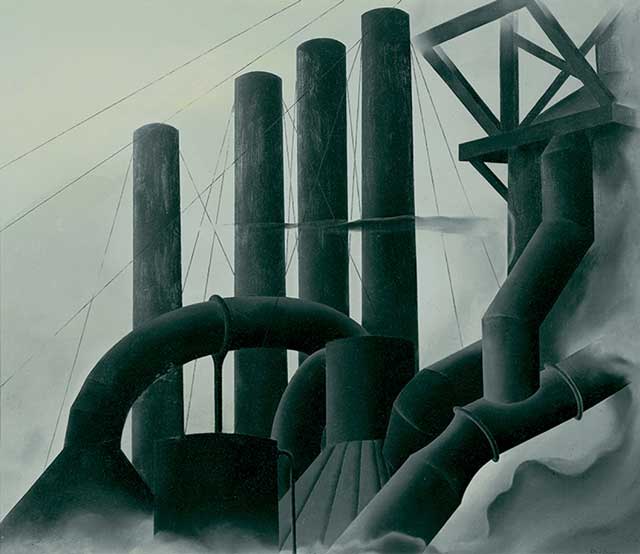Great Works: Pittsburgh, 1927 (87 x 101.6cm), Elsie Driggs
Whitney Museum of American Art, New York

The question which preoccupied so many painters from the New World in the 20th century was this: if America was to shuck off Europe, and begin to make itself anew, what was to be its defining theme? Was it essentially a rural place on an awe-inspiringly heroic scale – as the Hudson River School had shown it to be in the middle of the 19th century? Perhaps, on the contrary, in this brash new century, it would define itself by the particular, epic qualities of its extraordinary urban scenes, as Elsie Driggs seems to suggest in this painting of the Pittsburgh steel mills during the 1920s.
Now that heavy industry is dead in our land, we are so ready to damn it to hell and back. But what of the time when it meant prosperity, power, wealth, industrial muscle? Here it is seen through the eyes of a woman for whom it was an awe-inspiring, living reality. She is not wearing rose-tinted spectacles. This is not socialist realism – there are no grinning humans here in the company of flowers, mattocks raised. There is, however, much that is positive about this scene, much that seems to demonstrate a kind of settled, primitive faith in what technology is achieving. This painting has a reverential hush about it, as if all sound has been blocked out – Piero della Francesca shares that quality. The forms are austerely sculptural, almost ostentatiously so, as if these gorgeous interlocking forms have been created, singled out, to please the eye of the connoisseur. They are the present writ large, but they also seem to be apprehended, at least in part, as abstract forms – you can imagine an abstract painter robbing them of all contemporary content by doing very little at all. The light suggests a kind of gentle benediction. There is a mystery in the industrial haze that wreathes about these huge, velvety-grey, tube-like shapes, a coming into being of something strangely alluring.
The scene is one that Driggs remembered from her childhood, passing by the smokestacks of the steel mills at night by train, against a rose-tinted sky, which we can just about glimpse through the smoky haze. It must have possessed a hulking air of eerie menace when seen by a child in all its hugeness and indomitability. When this painting, made long after those sightings, was first shown in New York, her gallery described the work as evidence of a new "classicism" in American painting – such was its austere formal rigour. And the addition of all that thin cabling, connecting up the shapes, adds to our feeling that the entire scene is bounded by the mysterious rules of geometry.
Painted chimneys can look very harsh and forbidding. These forms have a malleable quality to them, as if they are freshly pulled and twisted into the forms in which they currently find themselves. They seem almost to possess a musical quality too, as if, in spite of their somewhat forbidding colour, they are allied to the brass section of the orchestra. There are essentially two shapes: the bent and the straight. The four vertical smokestacks seem to be climbing the sky, with a determined regularity. Each one is like its brother, a massed platoon of working men, on the march into the future. In front of them, the forms are quite different. They seem to be in organic motion, writhing and twisting about. Because the entire scene lacks a larger urban context – they exist amongst the mist that they have themselves generated, which drifts about hither and thither like scraps of softening veil – they seem both heavy and spectrally weightless, themselves and their painted simulacra.
There is also note of optimism here, we can't help but think – five years before she made this painting, Driggs was studying in Italy. She was greatly taken by the Futurists, a grouping which also allied industry, speed and technological endeavour with the triumph of the future.
ABOUT THE ARTIST
Elsie Driggs, who was born in Connecticut in 1898 and died in New York in 1992, was, along with Charles Sheeler, a member of the so called "Precisionist" school of industrial landscape painters of the 1920s. Her later work encompassed mixed-media works and other varieties of figuration.
Join our commenting forum
Join thought-provoking conversations, follow other Independent readers and see their replies
Comments
Bookmark popover
Removed from bookmarks